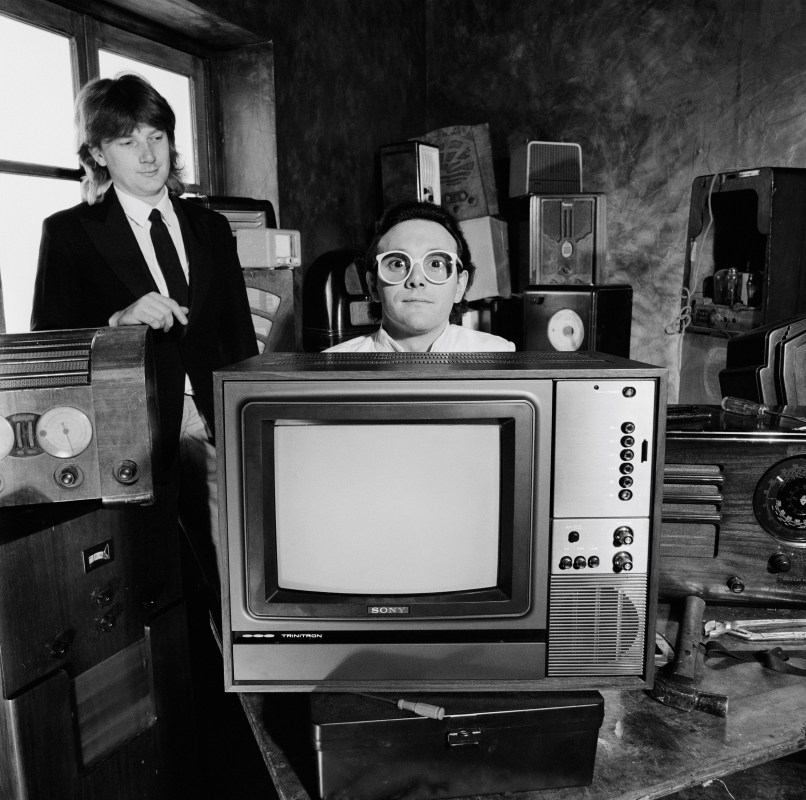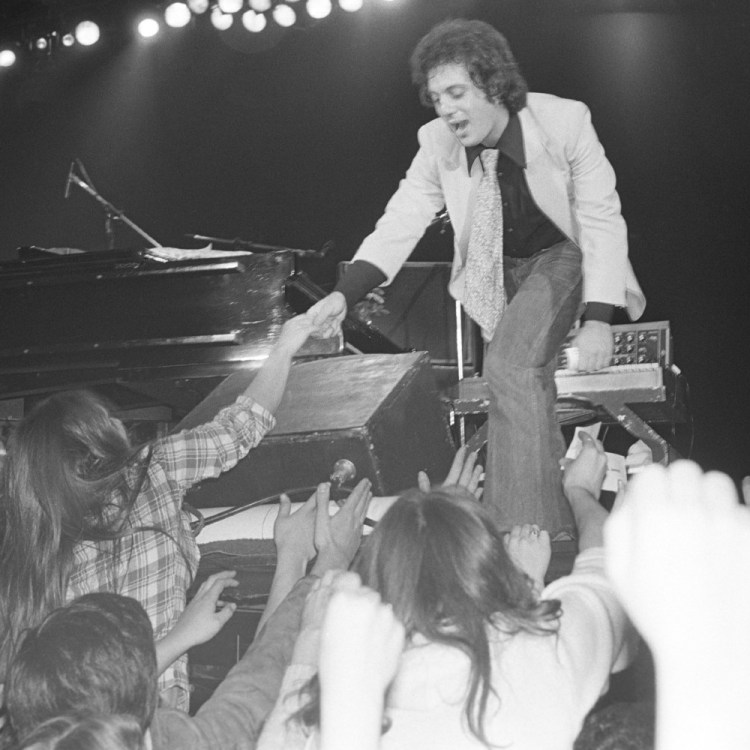That song…again?
We’ve all had these thoughts: “That song is just…everywhere. I think I once loved that song, but now that I’ve seen it in all those films, I hate it. I thought I hated that song…until I kept on hearing it on TV. Funny — now I love it.”
See, There are hit songs, and then…
There are songs that are bigger than hits.
These are the songs that have become an inescapable part of our landscape, songs that haunt us and reward us and tickle us and torture us and remind us of better times and worse times and times that were neither better nor worse. These are mall songs and Target songs and Bar Mitzvah songs and hotel bar songs and wedding songs and songs that your aunt asks you if you like and songs used again and again by every music supervisor and advertiser.
OhI’mWalkin’OnSunshineWHOAohhhh!…HeyHoLET’sGo!HeyHoLET’sGo!…I’m diggin’ those Good Vibrations…OhhhhhI’veHadTheTimeOfMyLife….
They are generational touchstones, generational celebrations, generational annoyances, and the ubiquitous pop of our media wallpaper age!
But at some point, each of these iconographic compositions were, believe it or not, “just” songs.
So, friends, I thought it would be interesting to write about how these gigantic songs were created, and how they became part of the fabric of our life and times.
Think: The 1980s. Summon up the decade in your mind, and what do you see? It’s likely that somewhere in that tumble of memory, an MTV logo popped into your head.
And if you think of MTV, it’s very likely you may hear one single song in your head:
Video Killed the Radio Star.
On August 1, 1981, the date when MTV signed on for the very first time, the first video they ever played was “Video Killed The Radio Star” by The Buggles. In the 37 years since, whenever there is a retrospective on MTV or a reflection on their history, it is very likely that they will play that same Buggles video which served as an announcement that the new age was upon us.
“As we were leading up to the launch, there was a mad search for what would be that first song,” remembers the legendary Mark Goodman, one of the original MTV VJ’s. “What would be the one that would kick everything off? And they came up with this, knowing full well it would piss radio off. I came from radio, and two years before I had been working as a music director at a radio station, and we got that Buggles album and we didn’t play it – nobody played it! But suddenly After August 1, 1981, in Cheyenne, Wyoming and Tulsa, Oklahoma, all these kids were walking into record shops asking for this f*cking record that had been off the shelves since 1979.”
“Video Killed the Radio Star” was written in 1978 by Bruce Woolley, Trevor Horne and Geoffrey Downes. In 1979, both Woolley and The Buggles released separate versions of the song (Woolley’s is quite a bit more rocking).
“It only recently occurred to me that this song has the significance that it does,” says Bruce Woolley, 64, who has a long and rather spectacular history as a performer, producer, and songwriter (for starters, he also co-wrote another major generational touchstone, Grace Jones’ “Slave to the Rhythm”). “During the 1980s and well into the 1990s, I almost pretty much forgot about it. It wasn’t really earning any money and nobody was using it. But then in the late 90’s, it got used in The Wedding Singer. Then suddenly it appeared in a couple of films, and I think a lot of the credit for that goes to The Presidents of the United States. Their recording somehow changed the trajectory of the song. Now I realize that this is actually quite a significant tune.”
Tim Sommer: When I first heard “Video Killed the Radio Star” — and this is well before the association with MTV — I remember thinking it was a terribly sad song.
Bruce Woolley: The thing is, Trevor Horn and I read a lot of J.G. Ballard, who is a dark writer. I mean his science fiction is very dark, very dystopian — people actually use the word “Ballardian” to sum up a dystopian future. His story The Sound-Sweep is about an opera singer who is out of work because there’s no call for acoustic music anymore, it’s all done subliminally — so this is a very sad idea about the passing of skills. At the time we wrote the song, the words “new technology” were in the news because Fleet Street (where, for centuries, the London newspaper business was traditionally located) was closing down and the big printing presses were under threat, you know, computers were appearing. And Thatcher was on the scene. When we had originally moved to London in the 70’s, it was almost like Victorian England. So a lot of that was disappearing and it was all getting gentrified and cleaned up, and the concept of “Video Killed the Radio Star” came out of all that. It’s a lament, it’s a lament for an age, it’s a nostalgic look at how things change. So there is sadness there, I think so. But because it’s such a jolly tune you know, that bit tends to get overlooked, but you spotted it! A lot of people think its nice, cheery pop song.
If you look at the song, the chords bear quite a lot of relation to Andrew Gold’s “Lonely Boy,” actually. Yes, I’m serious. Don’t tell Andrew Gold – actually, I think he’s no longer with us — it’s not plagiarism, it’s just that the writing itself had its root in Andrew Gold, 10cc, Supertramp, ABBA, that kind of pop thing. And somebody said that I’d copied “Ruby Tuesday” on the bridge section, which I can kind of acknowledge. But the recording, that’s a different matter entirely and that’s where Trevor and Geoff Downes kind of stepped in and took a few risks with the whole arrangement. Trevor would come around to my flat and I would go around to his place and we’d listen to Kraftwerk’s Man Machine, like you did in those days, you put it on the hi-fi when the flatmates were out and get stoned and listen to this amazing record that was unlike anything we ever heard before. Kraftwerk, I think, were essential to The Buggles sound.
Although a number of sources state that you and Trevor Horn wrote “Video Killed The Radio Star” on your own, it is, in fact, credited to you, Trevor, and Geoff Downes.
BW: Trevor and I had written two songs, “Clean Clean” and “Video Killed the Radio Star,” and Geoff Downes came in to help us arrange those songs. Now, this is all semantics and terminology, but Geoff didn’t really write either of those songs. Trevor and I wrote them around a piano, and with guitars and a bass – you know, here’s the song, this is the words, this is the chords, this is the tune, and so on. Geoff came in and did some really significant arrangements, and so Trevor and Geoff sat me down one night and said, “Look, Geoff has done these parts for these songs, I think we should cut him into the songwriting.” Trevor and Geoff were really a team by this point, and they were trying to get a deal with Island Records, and it would help them if they had that credit so it looked like they were the creative team. So I said, “Let’s face it Trevor, Geoff hasn’t really written these songs, you and I have, but maybe there is a case for giving Geoff some share of this.” So we came up with this solution: instead of splitting it three ways, we decided to do one song 50/50, and the other song three ways. In order to make the decision about which of the two songs to split which way, we had to toss a coin. I was fortunate enough to get the heads, and so I got the 50 percent of “Video,” and we split “Clean Clean” three ways. I’ve never contested any of that and neither has anyone else. It seemed to be a fair balance in the scheme of things. All of us have done sufficiently well enough since then with our other projects that none of us have ever worried about it or contested any of this, which is quite nice. We are all still pretty good friends, which is more than you can say about a lot of guys who have known each other for 40 years (laughs).
Often when a song is that big, years later, it ends up in the court, so it’s really nice to hear that hasn’t happened.
BW: Yeah, I’m really glad that’s not happened. I mean, there were a couple of hairy moments…it came up when Nicki Minaj and Will I Am sampled it on “Check It Out.” Geoff was a bit reticent about letting them do that, but that didn’t actually have anything to do with us — he sort of had another issue with Universal Music and he thought he could use that as leverage. I persuaded him that perhaps that wasn’t a very good idea, and it went ahead. And Trevor actually blocked a TV advert because he didn’t think that we should be advertising stuff, but this is around the time it stopped being a negative for someone to use their song in a commercial. So I spoke to Trevor and I said, “Look, this is a way we can all make money out of this. You know, everyone else is doing it, why shouldn’t we?” It used to be if your music was in a TV commercial you were the lowest of the low but now it’s the opposite.
In 2017, Woolley re-recorded “Video Killed the Radio Star” with vocalist Polly Scattergood and his son Kit “Keypad” Woolley under the name Bruce Woolley & Polly Scattergood with the Radio Science Orchestra.
The revised “Video Killed the Radio Star” is well worth hearing. It is a haunting, intense, effective version of the song that seems to simultaneously access an oppressive, damp, and rusted steampunk future and a deeply emotive past. The first half of the piece is chilly with the elegiac influence of Kate Bush, Robert Wyatt, and This Mortal Coil, but then it (almost literally) dissolves into a kind of sugary space bubblegum that sounds like astronauts high on ecstasy trying to locate the endlessly orbiting corpse of Laika the Spacedog. In all honesty, I actually prefer this newer version to the more famous, zippy, syndrummy Buggles version.
“I mean we have got to credit Polly Scattergood with that,” notes Woolley, “because she’s such a great singer in my opinion. And I was an enormous fan of hers before we met. My son, Kit, said ‘Dad you’ve got to listen to this singer,’ and he played me “Wanderlust.” And Polly’s been signed to Mute Records, Daniel Miller’s label, and he, of course, is also a great Ballard fan, so there’s a nice connection there. Daniel Miller did TVOD by the Normal, and I think that was also a big influence on ‘Video Killed the Radio Star’, so it’s all come full circle.”
“’Video Killed The Radio Star’ has become a cultural icon,” adds Mark Goodman, who is now a prominent voice on Sirius XM, particularly on the unique music-talk Volume channel. “It’s like what happened with ‘Don’t Stop Belivin’ and the Sopranos. These were existing songs, they were there, and then they were used in a certain way they caused them to transcend something, something else happens. Maybe it’s a happy accident, but if somebody says ‘MTV,’ they likely don’t go first to Duran Duran, they go to The Buggles.”
This article appeared in an InsideHook newsletter. Sign up for free to get more on travel, wellness, style, drinking, and culture.

























